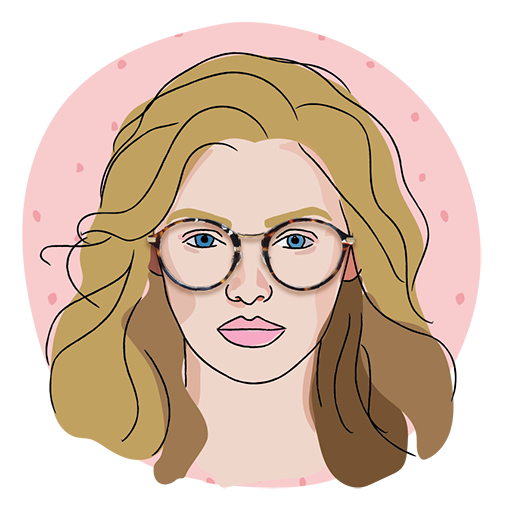![]()
Most of the guides you’ll find about choosing eyeglass frames get into face shape, skin tone, and personality. This one will too. Clearly, eyeglasses make a fashion statement and selecting a style is the fun part of the process.
You can advance quickly to subsequent sections of this guide by clicking the links below.
However, assuming you’re getting prescription glasses to address your vision issues, the first thing you should consider is your prescription.
What’s your prescription?
You’re only going to love your eyeglasses if they give you the best possible vision. So it’s important to realize certain shapes and materials are better than others and these depend on the type and strength of your prescription.
- Single vision
A single vision prescription is considered standard and gives you the greatest leeway for selecting a style. However, if you have a strong prescription your lenses are bound to be thicker and you’ll want smaller frames. - Plus and minus prescription
Your single vision prescriptions will beplus (positive) or minus (negative).- Plus makes your eyes look bigger—Larger lenses will magnify the effect.
- Minus makes your eyes look smaller—Your lenses will be thicker at the outer edges. Shorter frames are recommended to reduce the effect.
- Bifocal
Bifocal lenses have two different prescriptions in one lens, so your prescription needs enough vertical space to accommodate the lenses. - Progressive
Progressive prescriptions include three areas of vision: distance, intermediate, and near. The lenses must be perfectly centered over your eyes and the frames must allow for lenses large enough to provide surface area for all three focal lengths.
What’s your face shape?
Chances are, you’ll find it tricky to easily identify your face shape (possibly even when presented sample photos or illustrations). Popular descriptions include round, oval, square, triangle, and heart-shaped. Your face may be a combination of more than one.
You need not dwell on your choice or over-emphasize the assessment of your face shape. However, opticians will often offer advice aiming to pair specific styles of frames to specific face shapes to help best complement your features.
That said, you might have a specific style of eyeglasses in mind that suits your style. To be clear, these are not unbreakable rules, but merely guidelines. If you’re interested in applying this type of advice consider the following when selecting frames.
Round face

Rounder faces have softer angles with wider cheekbones, foreheads and jaws.
- Square or rectangular frames have bolder, more angular lines. They’re often wider which can enhance your face by making it appear slimmer and longer.
- You may want to avoid rimless frames, round frames and small frames, which make a round face look even rounder.
Oval face

An oval face has slightly wider cheekbones but narrows above and below at the forehead and jaw.
- Oval faces are the most versatile and easy to fit with a variety of eyeglass frames.
- Consider frames with a strong bridge that are wider than the broadest part of the face and are geometric in shape.
- Avoid eyeglasses that are overly large and cover up much of your face because they may throw off the natural symmetry of your face.
Square face

Square face shapes have more angular lines. Cheekbones, foreheads and jaws tend to be equally wide.
- Look for oval or round eyeglasses that soften the angularity and sit high on the bridge of the nose.
- Rounded frames will add balance and provide a thinner appearance.
- You may want to avoid rectangular eyeglass frames because they can further sharpen your angular features.
Heart-shaped face

Heart-shaped faces are widest at the forehead and gradually narrow down to the jaw.
- Try eyeglass frames slightly wider than your forehead to create a sense of balance.
- Bottom heavy frames with low-set temples—round or square—add width to the narrower part of your face.
- If you have a heart-shaped face be wary of styles color that draw attention to your forehead.
As you’ve gathered, opposites attract when it comes to finding frames to complement your face shape. Eyeglasses that contrast your facial contours bring symmetry and balance to your facial features.
Does color count too?
Maybe… sort of… not really… and… It’s completely up to you. Most people prefer neutral colors including black, brown, or even tortoise. These common eyeglass frame color choices make it easier to match with different hair colors, eye colors, and skin tones.
However, you may want to make bolder color choices or own several sets of specs to suit your mood. Following are some smart tips for choosing frame colors to enhance your features.
Skin tones
When selecting eyeglass frames by color, skin tones are generally more important than your hair and/or eye color.
- Warm skin
Does your skin have a yellow, bronze or golden cast? If so, you have a warm complexion. Complementary frame colors include light tortoise, browns shades, gold or honey, beige, and olive green. You may want to avoid contrasting colors such as pastels as well as white and black frames. - Cool skin
You have a cool complexion if your skin has pink or blue undertones. You’ll want to avoid colors that create a washout effect. Try silver, black, dark tortoise, pink, purple, blue, mauve and gray frames instead.
Eye color
Eye color is another thing you can factor into your choice of frames—or not. You may find it fun to consider options based on the color of your eyes.
- Blue eyes
Contrasting brown tones, including tortoise-shell, help blue eyes pop. On the other hand, matching tones such as cobalt, midnight, or steel blue may give you an edge you like.

- Green eyes
A color in in the plum-toned family is complementary. Want to go bolder? Try something in emerald-green.

- Brown eyes
A lavender color will deliver contrast to make brown eyes stand out. A matching tortoise or coffee shade will help deepen your natural eye tone.

- Hazel eyes
A greenish frame emphasizes the gold in hazel eyes. Go for a brownish tone to bring more depth to your hazel eyes.
Hair color
Does the color of your hair matter? Again, this is your call. There may be certain shades you choose or avoid.
- Black hair
Darker frames including black or tortoise shell work nicely—or you can experiment with brighter colors.

- White or gray hair
Experiment. Bright colors may look best.

- Red hair
Fashionistas claim red hair begs for bold frames. Experiment with color. Go with darker frames. Avoid red frames.

- Brown hair with red undertones
If you have auburn hair, tortoise shell frames are bound to look great. Also, try frames with warm and earthy colors.

- Brown hair with blonde undertones
If your brown hair lacks red undertones, dark frames—black especially—will look nice. Also, experiment with pastel colors.

- Blonde hair
Do you have dark tones in your blonde hair? Look for warm colors. Tortoise shell frames will work too. Those with ashy or platinum blonde hair should consider pastels and other bright colors to create interesting contrast.

Personality and purpose matters
Obviously, your glasses can make a fashion statement. On the contrary, you could aim to make them as unnoticeable as possible. And, in the space between, you could simply make choices to reflect your style and taste.
In other words, your personality matters too. Your eyeglass frames might say as much or more about your style as your outfit or shoes.
Frame thickness
Thick frames are bigger and bolder. You might choose them to go bold or because you have strong facial features you want to de-emphasize. Most often, thick frames are offered in dark colors, but they’ve become more popular and are now offered in a variety of colors and clear. Thin frames are the way to go when you don’t want to draw attention to your specs. They blend into your face more helping to emphasize your facial features.
Lifestyle
Think about the activities you’ll do while wearing your eyeglasses.
- Are you active? You’re bound to like frames that can twist and bend without breaking.
- Are you a gamer? If so, you can choose stylish frames that enhance the gaming experience.
- Spending your days in an office? Look for glasses that instill a sense of confidence and professionalism. You may prefer classic shapes and traditional colors and patterns.
- Want to show off your creativity? Go bold. Add some flair with modern shapes, cutouts, colors or patterns. Try a vintage look if it suits your style.
How you feel is what matters most
Here you are at the bottom of lengthy page about choosing your eyeglasses based on your prescription, face shape, coloring, and personality. Hopefully, you’ve gathered some ideas that will help you make a smart selection.
But let’s be honest… Much like everything you wear, the choice (or choices) you make regarding your glasses ultimately comes down to how you feel when you look in the mirror—which is precisely what you should do.
Put ‘em on, look in mirror and ask yourself: do you like the look? Feeling good about what you wear helps you wear it well.
Do you have a little room in your budget to have multiple pairs of glasses?
Maybe your mood, the company you keep, your outfit or where you’re headed in your specs inspires you to invest a few bucks in having more than one set of frames. Perhaps you want to don a business look at work and flirt with your fun side when the weekend rolls around. Having a small collection of frames could make you feel ready to rock any situation.
Whether you’re choosing your first pair of glasses, new replacements, or expanding your eyewear wardrobe because you find it fun, remember what matters most is your personal taste.


